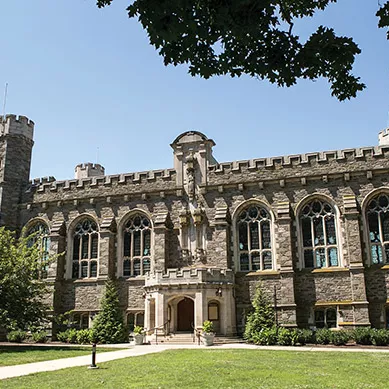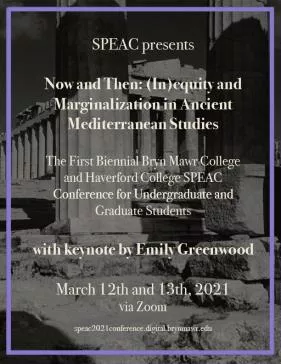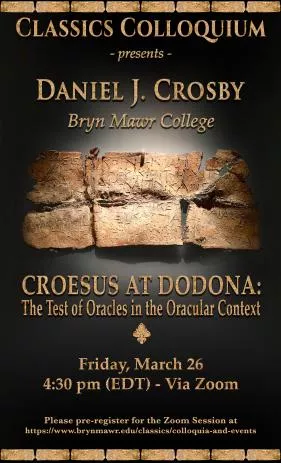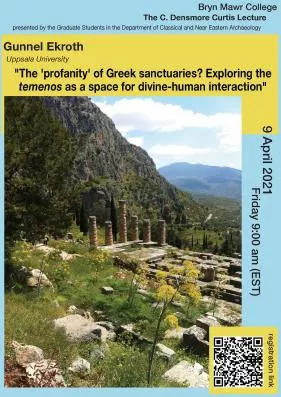Colloquia and Events 2020/2021
Fall 2020 Classics Colloquia
Sept. 11
Rocki Wentzel, Augustana University
“Technological Humanity in Blade Runner 2049"
Wentzel will be discussing the way that Greco-Roman myth emerges to illuminate ideas of heroism and humanity through the replicant K in Blade Runner 2049. Some of the myths included are those of Pygmalion, Oedipus, and Narcissus.
Sept. 18
Reports from the Field: News from Abroad
Undergraduate and graduate students in the Departments of Classical and Near Eastern Archaeology and Greek, Latin and Classical Studies present their learning experiences away from the College this Friday, September 18, in the Reports from the Field: News From Abroad. Zoom presentations start at 4:30 pm. Reports reflect on learning opportunities, such as study abroad programs and the Hannah Holborn Gray Research Fellowships, internships in museums, art galleries and archives, and online courses. These Reports provide an important chance for the students to assess their experiences and to let other students know what sorts of opportunities may be available to them.
Sept. 25
Lisa Raphals, University of California, Riverside
“Gendered Skill: Chinese and Greek Skill-Knowledge Analogies from Archery and Weaving”
Weaving and archery are strongly gendered skills, and both occur repeatedly in both Chinese and Greek accounts of skill and ethics, especially in skill-knowledge analogies that compare mastery of a skill or craft to the practice or process of acquisition of knowledge, either of a specific skill, or to broad 'skills' of wisdom and ethics. Some analogies liken these skills to various aspects of ethics, wisdom and government. Examine a range of Chinese and Greek analogies and metaphors based on comparison of the mastery, practice, or acquisition of two technical crafts, archery and weaving, and the mastery, practice, or acquisition of wisdom or ethical or political virtue. Archery and weaving are both embodied practices that have strong cultural and even mythological resonances. Each is culturally important in both Chinese and Greek contexts. Both are gendered, and the performance of each is an important aspect of gendered virtue. Skill in archery is primarily attributed to men, while weaving is primarily performed by women. Both are also the basis of powerful metaphors. Finally, analogies to both are used extensively in philosophical argument.
Oct. 2
Denise Demetriou, University of California-San Diego
“Living Between Two Worlds: Phoenician Immigrants in Fourth-Century BCE Athens”
This talk focuses on a history of immigrants from Phoenician city-states—Sidon, Asheklon, and Kition on Cyprus—living in Athens in the fourth century BCE. What were the effects of migration on the Phoenician immigrants? What were the effects of migration on Athens? Using a series of bilingual inscriptions, Demetriou shows: first, that Phoenician-speaking immigrants adopted or created practices that allowed them to adapt to migration as individuals; second, that they formed immigrant communities that mediated their interactions with the political authorities of their host state; and, third, that migration led to the construction of new immigrant identities. Together, these three points reveal the adaptive practices and new identities that enabled immigrant integration in the Greek world.
Oct. 9
Theodora Jim, University of Nottingham
“Salvation on Earth: Soteria and Saviour Gods in Ancient Greece”
What did it mean to the ancient Greeks to be ‘saved’, and how did they experience it? Soteria is one of the most important blessings in the relationship between men and gods. It is sought from the gods in circumstances ranging from warfare to seafaring, childbirth, healing, farming, earthquakes and so on. Contrary to what we may expect from the Christian eschatological sense of ‘salvation’, it is striking that Greek soteria and ‘saviours’ gods were almost always concerned with deliverance and well-being in this world rather than the next. Combining close analysis of epigraphic and archaeological evidence, this talk will explore the multivalent power of these ‘saviour’ gods and the different values attached to soteria. The evidence challenges us to rethink what we think we know about this Greek concept, and to recognize the importance of ‘salvation’ on earth.
Oct. 16
Christelle Fischer-Bovet, University of Southern California
“The Power of Statues: Constructing Imperial Narratives in Ptolemaic Egypt”
The power of statues in shaping our memory of the past has been and is now perhaps more than ever at the center of public attention and political discourse. Narratives about removing or returning statues can take multiple meanings depending on the historical context. This talk examines how the Ptolemies—the successors of Alexander in Egypt (323-30 BC)—by orchestrating the return of Egyptian statues and objects (supposedly) stolen by the Persians to Egypt, engaged with the cultural memory of different population groups: Egyptian priests, Greco-Macedonian elites, Egyptian population. They were reshaping memories hostile to the successive Near Eastern empires and adapting them to a new context, while at the same time constructing Egypt as the new imperial center.
Oct. 23
Patricia Eunji Kim, New York University
“Making the Queenly Body in the Hellenistic World”
If male nudity was a costume in Greek art, how did royal women throughout the Hellenistic ‘wear the female body’ in their representations? In this talk, Kim discusses the ways that the Ptolemaic queen’s body was both conceptually and physically made for diverse, public audiences to see. Building on important conversations around fusion, hybridity, and cross-cultural entanglements in Hellenistic-period visual and material culture, Kim turns her focus to the stakes of the Ptolemaic queen’s body in dynastic and imperial politics.
Oct. 30
Aimee Genova, Center for Hellenic Studies, Harvard University
“The Heraklion Archaeological Museum and What Never Came To Be: The Venetian Loggia and its Abandoned Plans”
What can the abandoned original plans of the Heraklion Archaeological Museum tell us about the history of Cretan archaeology? Built ca. 1620s by Francesco Morosini, the Venetian Loggia stands today as the Municipal Town Hall of Heraklion, but it was once slated to house precious historical artifacts as the location of the archaeological museum in Heraklion. While the Venetian Loggia never became the archaeological museum that some Cretan archaeologists hoped for, local Cretans built upon networks they had forged with foreign agents to eventually develop an internationally renowned museum elsewhere in Heraklion. Using archival collections from the American School of Classical Studies at Athens (ASCSA) and the Heraklion Archaeological Museum (AMH), this talk places the Loggia’s complicated history within the systems of archaeological networks that emerged as a consequence of the political situation of Crete during the late nineteenth and early twentieth century.
Nov. 6
Maggie Popkin, Case Western Reserve University
“Imagining the Roman Empire Through Its Souvenirs”
Souvenirs and memorabilia of places, people, and spectacles abound from the Roman Empire. Although often overlooked, ancient souvenirs offer indispensable evidence of the experiences, interests, and aspirations of a broader range of Romans than we can access through literary accounts alone. This talk examines how souvenirs constructed imagined cultural affinities around the empire among its heterogeneous population. At the same time, however, souvenirs strengthened local and regional identities and excluded certain groups from the social participation they afforded so many others, thereby reifying social power structures. Finally, Popkin explores how souvenirs, which connected people around the empire without the direct intervention of Rome, cause us to rethink the place of the city of Rome in the popular imagination of the empire's residents.
Saturday, Nov. 14 at 5:00 pm
The Agnes Michels Lecture, sponsored by the Graduate Students in the Department of Greek, Latin, and Classical Studies
Frederick Ahl, Cornell University
“The Case of the Trojan Tower: Seneca Solves a Virgilian Mystery”
“In Aeneid 2. 451-468, in a narrative evoking a famous passage in Iliad 6, Aeneas claims to have destroyed, during the sack of Troy, a tower overlooking a precipitous drop situated in Priam’s palace complex. Andromache used to drag (trahebat: 357) her son Astyanax there, he notes, to watch the fighting. In Seneca’s Trojan Women (1068-1103), however, in a passage echoing and modifying Euripides Trojan Women 725-739, a messenger says the tower, where Priam, with Astyanax in his lap, used to oversee the fighting was the only tower still standing after the sack of Troy. From its top, he says, Astyanax leaped on his death, foiling those who, in other traditions, were intent to throw him down. Why, then, does Virgil’s Aeneas claim that he, a Trojan, had destroyed this famous Trojan tower before Troy fell and before Astyanax died?”
Dec. 4
Douglas Cairns, University of Edinburgh
“Homer, Aristotle, and the Nature of Compassion”
This paper explores aspects of pity or compassion in Homer (especially Iliad 24) and Aristotle (especially the Rhetoric). Of the cluster of terms that refer to compassionate responses to others’ suffering, it is eleos that looms largest not only in Greek literature (e.g. Homer) but also in Greek literary and rhetorical theory (e.g. Aristotle). Indeed, eleos is perhaps the most salient among all the emotions to which Greek literature appeals, just as it is in ancient literary theory. Literature (broadly conceived) provides our best evidence for the dynamics of ancient Greek eleos, at it does for most emotions – it regularly gives us their eliciting conditions, the appraisals and evaluations that they entail, their phenomenology, their symptoms and expressions, and the characteristic patterns of behaviour with which they are associated. Literary/rhetorical theory both generalizes from and informs literary/rhetorical practice, and in the particular case of eleos raises some of the questions that we shall need to answer if we are to understand the concept. This paper is not a lexicographic study but looks also at other terms from the same general Wortfeld as eleos, examining the phenomena of compassion as well as the ways in which they are labelled and conceptualized.
Dec. 11
Mary Norris
“Intrepid Women Travelers in Greece”
Women have created a subgenre of Greek travel literature. Authors have included a nineteenth-century British composer, a Greek-American novelist, and a contemporary American poet. Two remarkable Bryn Mawr alumnae—Eva Palmer Sikelianos and Doreen Canaday Spitzer—also inspired books, both academic and personal, that draw on their love of Greek drama and archeology. The author of Greek to Me, Mary Norris, will dig into the question of who among women gets to travel and who among women travelers pulls a book out of her experience.
Spring 2021 Classics Colloquia
February 12
Aimee Genova, Center for Hellenic Studies
“The Heraklion Archaeological Museum and What Never Came To Be: The Venetian Loggia and its Abandoned Plans"
What can the abandoned original plans of the Heraklion Archaeological Museum tell us about the history of Cretan archaeology? Built ca. 1620s by Francesco Morosini, the Venetian Loggia stands today as the Municipal Town Hall of Heraklion, but it was once slated to house precious historical artifacts as the location of the archaeological museum in Heraklion. While the Venetian Loggia never became the archaeological museum that some Cretan archaeologists hoped for, local Cretans built upon networks they had forged with foreign agents to eventually develop an internationally renowned museum elsewhere in Heraklion. Using archival collections from the American School of Classical Studies at Athens (ASCSA) and the Heraklion Archaeological Museum (AMH), this talk places the Loggia’s complicated history within the systems of archaeological networks that emerged as a consequence of the political situation of Crete during the late nineteenth and early twentieth century.
February 19
Grant Parker, Stanford University
“Obelizing Memory”
Obelisks are well known in contexts of ancient Egypt (e.g. Karnak, Heliopolis) and ancient Rome (e.g., Campus Martius, Circus Maximus). Their physical movement has recently been studied with particular attention. This talk takes a broad and comparative view of obelisks as memory objects, focusing on ways in which they have mediated particular identities and aspirations, both individual and collective. How have obelisks functioned as monuments and how might this have changed between the age of the pharaohs and the digital age? How might we understand the relation between ancient obelisks and their ostensible modern spinoffs? Parker argues that obelisks offer a case-study in monumentality itself, a topic of urgent relevance in our times.
February 26
Lisa Maurizio, Bates College
“Female Imagination and Maternal Experience: Greek Myths of Infanticide”
Medea’s murder of her two sons may be the most well-known infanticide from antiquity, but she is not the only mother to direct murderous rage at her children. Lamia, Gello, Mormo, to name a few, who were once mothers and then became monsters, were reported to kill infants as well as young mothers. In current scholarship, these monsters are treated as products of an ancient Greek male imagination that functioned to determine female lives and reproduction. Maurizio proposes that these figures are female creations. They expressed maternal ambivalence, a universal female experience, that is especially salient in societies with high maternal and infant mortality rates such as ancient Greece sustained. Maurizio surveys a range of ancient evidence such as burial practices of infants and mothers and the Hippocratic corpus as well as contemporary women’s writing about infanticide and psychoanalytic concepts of maternal ambivalence in order to argue that myths of infanticide did not serve a male regulatory function so much as a female expressive one. Ancient sources codified female oral traditions in writing and incorporated such expressions. Thus imagined and real acts of infanticide in ancient Greece were largely female prerogatives that can be apprehended through an understanding of maternal sentiments beyond a romantic notion of devotion and attachment.
March 5
Mario Telò, University of California
“Batrachopolitics: Crisis, Animal Anomaly, and the Stubbornness of Form in Frogs”
Do frogs have anything to do with politics? How can we see the title of Aristophanes’ play and the Chorus’s amphibian identity as generative of political discourse? In this paper, Telò suggests that bringing the animal to the center of critical attention may help us read the politics of Frogs beyond the binary of aristocracy vs. democracy, Aeschylus vs. Euripides. Rather than thinking in terms of polarized constitutional and ideological regimes, Telò wishes to look at how Frogs anticipates the democratic politics theorized by postmodernist thinkers: as a disruption of normativity, hierarchy, and collective—potentially homogenizing—modes of feeling. Telò locates effects of reading that bespeak a kinship between Aeschylus and the frogs as embodiments of disidentification and dissensus—resistance against the Symbolic’s attempts at closure and totalizing incorporation. In particular, Telò considers the political ramifications of the aesthetic convergence between the frogs’ uneven skin and Aeschylus’s stylistic roughness (a trachutês that is inscribed in the word batrachos). Aeschylus’s kinship with the amphibian animal amounts to political anomaly in the etymological sense of anomalia (“unevenness, unequalness”), an experience of disunity that Deleuze and Guattari see as a form of deterritorialization. This dissensual force emerges from the subliminal Aeschylean appropriations of amphibian sound, but also from the parallelism between the frogs’ inertia, their stuckness in the marsh’s still water, and the stubbornness of Aeschylus’s form, the Niobe-like isolation, rigidity, and solid mass of his words, which hold their ground against what we could call syntactical consensus. In these and similar instantiations of political aesthetics, Frogs shows the anti-normative, emancipatory potential of “batracho-being”—that is, of the “minoritarian” temporality of slowness and inertia, resisting through the depressed position of stagnant life.
March 12 & 13 - SPEAC (Students Promoting Equity in Archaeology and Classics) CONFERENCE
Now and Then: (In)equity and Marginalization in Ancient Mediterranean Studies
March 12
Keynote Lecture: “A Classical Primer for Anti-Racism / An Anti-Racist Primer for Classics”
Keynote Speaker: Emily Greenwood, Yale University
March 19 at 4:30 pm (EDT)
Bice Peruzzi, Rutgers University
"Creating Permanent Memories? Tomb violation and Collective Memory in Pre-Roman Apulia"
Tomb re-openings in the ancient Mediterranean world have been generally treated as transgressive acts of violation against the memory of the deceased. Yet, in pre-Roman Apulia re-opening and re-using tombs seem to be a widespread and accepted phenomenon. This paper analyzes the relationship between graves and collective memory, focusing on tomb violation in Central Apulian necropoleis in the 6th-4th centuries BCE. I argue that this practice, paired with the general lack of grave markers and post-depositional rites, ancient looting, and the unclear boundaries between settlements and necropoleis is part of complex local strategies where the local communities alternately rejected, incorporated, and reinvented memories of their own past to create a narrative about themselves and legitimize their newfound power.
Daniel J. Crosby, Bryn Mawr College
“Croesus at Dodona: The Test of Oracles in the Oracular Context”
When Croesus of Lydia was contemplating war with the Persians, he wanted assurance of success and sought to test the powers of the most famous oracles among the Greeks. When Croesus received the replies, he proclaimed that only Delphi was correct, which presumably means that the rest of the oracles were wrong. Herodotean scholarship has supposed that the tale reflects either Delphic propaganda working at the expense of its competition or a contemporary criticism of the value of oracular divination. In this paper, however, I challenge Croesus’ own notion and the underlying assumption of modern scholarship that only Delphi “got it right.” By comparing Croesus’ test question with the questions that consultants inscribed on lead tablets at Dodona, I argue that Croesus’ phrasing is troublingly ambiguous. What Croesus meant to ask was “What do I happen to be doing right now?” but in the oracular context in the inscriptions, the same question nearly always meant “What might I do to have good fortune?” This contextualization clears the other oracles of the blame of “falsehood”; it assigns greater honor to Delphi for the divine perspicacity to understand what Croesus actually meant; and it reaffirms the notion that Croesus simply did not understand how one was supposed to derive advantage from oracular divination.
*Please note: The lecture will be at 9:00 am (EDT)
The C. Densmore Curtis Lecture, sponsored by the Graduate Students in the Department of Classical and Near Eastern Archaeology
Gunnel Ekroth, Upsala University
“The “profanity” of Greek sanctuaries? Exploring the temenos as a space for divine-human interaction”
This presentation will explore the temenos concept from the point of view of sanctuaries as set apart for the gods but mainly used by humans, and how immortal and mortal practices and manifestations were to be accommodated within this space. The caretaking of a temenos as divine property required particular rules at sacrifices since human needs and desires were not always appropriate for the gods. Of particular interest are the handling of animals, the cooking and food consumption after sacrifices, the management of human waste as well as the impact of humans staying in temene.
April 16 at 4:30 pm (EDT)
The Agnes Michels Lecture, sponsored by the Graduate Students in the Department of Greek, Latin, and Classical Studies
Ruby Blondell, University of Washington
"Helen of Troy: The First Flapper Queen"
The title role of Alexander Korda's silent comedy, The Private Life of Helen of Troy, as played by the Hungarian Maria Corda, presents Helen as a figure of "European" exoticism enhanced by sets and costumes that elide the gulf between ancient and modern. This transforms her into "the first flapper queen" (a phrase used in publicity and reviews), and as such, into an emblem and celebration of Hollywood itself.
April 23 at 4:30 pm (EDT)
Korshi Dosoo, University of Würzburg
“Who Used the Magical Papyri?”
For nearly two hundred years the Greek and Demotic magical papyri have provided a fascinating source of information on the rich syncretism of Roman Egypt. Filled with instructions and evidence for curses, and love, healing, and divinatory spells, the corpus seems to offer a glimpse into the private lives of its users and writers, and yet, because we know very little about where and how the papyri were found, scholars have often only been able to make educated guesses about who these people were - wandering magi, Egyptian priests, or scholars dependent upon rich patrons. This talk will offer some thoughts on this question, drawing primarily on the few cases where archaeological or archival evidence allows us clear glimpses of ancient people who owned, used, and produced magical papyri.
April 30 at 4:30 pm (EDT)
Heidi Marx, University of Manitoba
“Theurgy, Oracles, and ‘Magic’ in the Life of Sosipatra of Pergamum”
Sosipatra of Pergamum is one of the last non-Christian ancient female philosophers about whom we have any information. Like Hypatia of Alexandria, she ran her own philosophy school in mid-fourth-century Pergamum. She is also represented by her biographer, Eunapius of Sardis, as an important theurgist and oracle. This talk will discuss aspects of Eunapius's portrayal of this intriguing woman, focusing on the way he uses her to critique both female Christian ascetics (the heroines of contemporary hagiography) and other theurgists who participated in more extreme ritual practices, such as coercing the gods and animating statues. These practices were ones that got figures such as Maximus of Ephesus, advisor to the Emperor Julian, into trouble as "magicians."
May 7 at 4:30 pm (EDT)
Jennifer Devereaux, Bryn Mawr College
“Self and Nature in Senecan Texts"
Challenging the intuition of Western individualism that a sense of self entails a sense of containment within the boundaries of the body, this paper reveals the systematic dissolution of embodied emotional experiences into the natural world in Senecan texts. Such dissolution, Devereaux suggests, represents an authorial technique that serves to organize the memory of emotional experiences in accordance with Stoic principles and beliefs about the role of contemplating nature in forming a sense of self. Focusing especially on the notion of sumpatheia -- the view that the whole of physical reality is an ordinary organism, with different parts connected such that an affection in one place leads to an affection in another – this paper will explore intercorporeality in the Stoic context, and the significance within that context of the boundaries between mind, body, and world being dissolved by memory traces that exist within and yet beyond the biological body.

Contact Us
Greek, Latin, and Classical Studies
Old Library 103
Bryn Mawr College
101 N. Merion Avenue
Bryn Mawr, PA 19010-2899
Phone: 610-526-5083
Radcliffe Edmonds, Chair redmonds@brynmawr.edu
Leslie Lawrence, Academic Administrative Assistant
Phone: 610-526-5083
llawrence@brynmawr.edu


